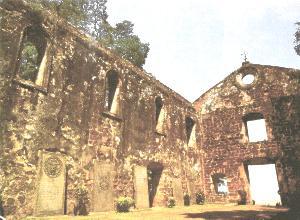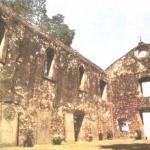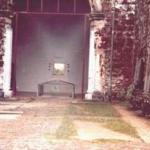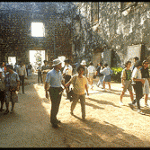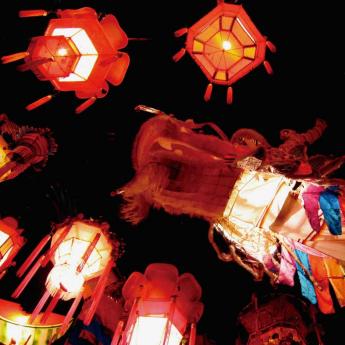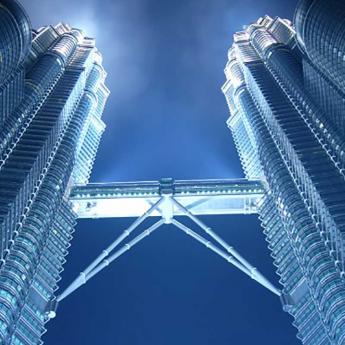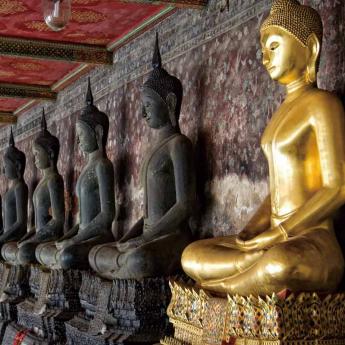The Ruins of St. Paul
Malacca has always fascinated me in many ways. I remembered, as a child, my parents would bring me on their regular sightseeing trips to Malacca and many a times, I would be awed struck by those old ruins and quaint buildings. I have always suspected that my love for ruins and old buildings were stemmed from those childhood moments. One particular building that remained in my memory is that of St. Paul's.
What's left of it now was actually a chapel during its heyday. During the times of the early Portuguese in Malacca, the chapel used to be known as the Chapel of the Mother of God (Madre de Deus) or Our Lady of the Hill (Nossa Senhora do Oiteiro). Built by one Duarte Coelho in the year 1521, the chapel was erected as a symbol of gratitude to Our Lady of Grace. The story, as related by Portuguese chronicler Joao de Barros of the 16th century, revealed that a fleet in the South China Sea attacked Duarte Coelho and his crew. However, during the worst moments, a sudden storm arose and the crew was miraculously saved. And that is how the chapel first came about?
Further history revealed that in the year 1548, the chapel was handed over to the Society of Jesus by the archbishop of Goa, Don Albuquerque. The famous guy, St. Francis Xavier was the one to received the title deeds on behalf of the society. During those days, the chapel was a highly respected building by the Portuguese and it was here that St. Francis Xavier preaches the Sunday Mass. The saint spent many long hours and nights in the chapel in prayer. It was also here that he wrote at least five letters under the dim candlelight.
Several miracles took place within the chapel or with connection to the chapel, including the cure of Joao Fernandez, who is a young boy of between 15 to 18 years old. One most spectacular event was the grand victory of a naval battle that took place while the saint was preaching. In the middle of his sermon, he suddenly stopped and was in ecstasy for a moment. Then he asked the people to pray for the successful outcome of the battle and victory was announced! Apparently, news had it that people saw the saint at the time and place of the battle encouraging the soldiers. How he was there while the battle was taking place at the estuary of the river Perlis, north of Malaya, was unknown. And somehow, this remains as one of the greatest miracles ever?
When St. Francis Xavier passed away, his body was put to rest in the chapel from 22nd March 1553 to 11th December 1553. Three years later, the chapel went into a phase of repairs and construction. It was here that the church almost lost its origins, as there were talks of pulling it down completely and rebuilding a new one. Then, there were plans to extend it. As the church is a place looked upon highly by the Portuguese, with it being the second Christian place of worship in Malacca, they finally decided to not destroy the entire building. Part of the walls and façade of the church were kept, including the windows and walls right up to the side door. Other parts like the old chancel and vestry were pulled down. The church was extended eastward. Several modifications were made to the overall structure whilst fitting in with the rest of the remaining structure. It took many years for the building to be completed. But I will not go into details of the building structure or what was added or what was removed. However, it was said that a small burial vault that was opened in 1592 right in the middle of the sanctuary was the burial place of St. Francis Xavier. Other burial locations were found within the church. A big square was opened and later divided into small compartments. Some of the famous names buried here includes the Mordomo (Major-domo) Goncalves (1568); Don Miguel de Castro, captain of Malacca and son of the Viceroy, Don Joao de Castro (1577); Pedro Martines S.J., second bishop of Japan (1598); Antonio Pinto Fonseca, Captain Geral do Mar e Terra nas Partes do Sul, (1635) (Captain-General of the Sea and Land in parts of the South.), and also Brother Theodore Mantel, who is a Belgian Jesuit.
In the year 1590, the chapel had new additions to its structure. A tower was built above the chancel and its annex. This place serves as the belfry and lookout point. The whole building was lime-washed in white, thus serving as a landmark for passing ships through the Straits of Malacca.
Many years later, the Dutch came to Malacca and overthrow the Portuguese. The church was then used for their reformed religion. Later, the Dutch abandoned it when the (present) Christ Church was built at the foot of the hill, located by the side of the Malacca Post Office. The new place that came up in 1741 was in commemoration of the centenary of the occupation of Malacca by the Dutch. Now, it is used as an Anglican Church and the St. Paul church became a part of the fortress. The tower was destroyed and a wide pillar was added to strengthen the building. Again, I will not go into details of the changes but if you want to know more, please check out the footnote. But after some changes here and there, the center of the church became a graveyard of sorts with tombstones scattered here and there. When the British took over Malacca, the church was used as a powder magazine for a while, but ever since then, it has been in total ruins.
Other changes took place leaving its historical markings behind at the quaint chapel. In 1930, the President of the newly formed Malacca Historical Society, Major C.E. Bone, did supervisions on the excavations of the church and the tomb slabs were fixed to the walls.
"To the Portuguese it was a place of worship; to the Dutch a church it was a burial ground and a fortress, and to the British, a powder magazine. Now, it is a place of worship and a great tourist attraction, because, there rested, for eight and a half months, the remains of a most extraordinary man of God - St. Francis Xavier."
Source: Robert Leo
* Many thanks to Robert Leo for his detailed historical account regarding St. Paul.
 ThingsAsian
ThingsAsian